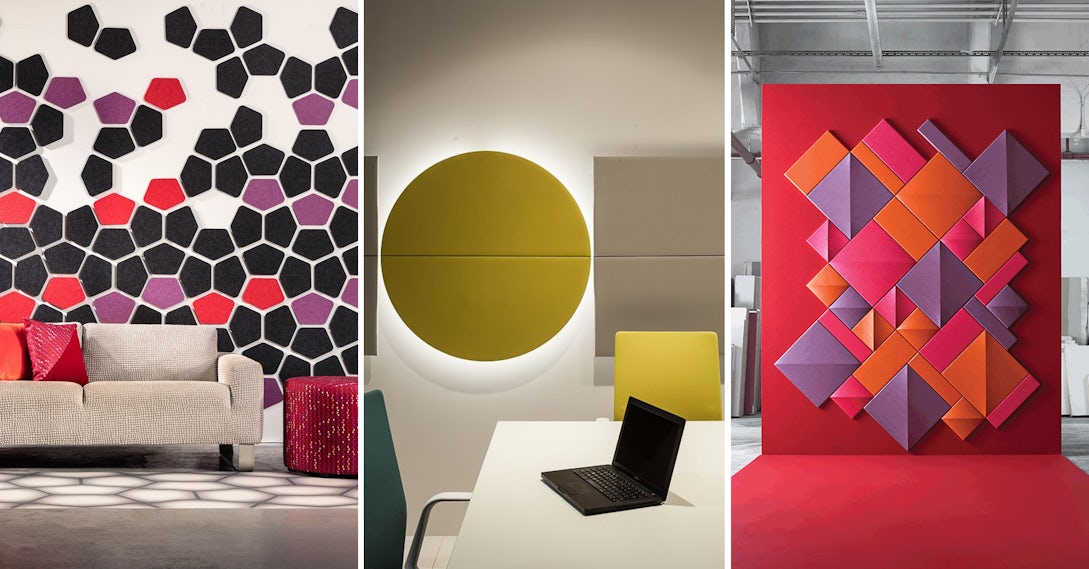Browse the Architizer Jobs Board and apply for architecture and design positions at some of the world’s best firms. Click here to sign up for our Jobs Newsletter.
This might be the golden age of acoustic panels. Thanks to open-plan offices and industrial warehouse conversions, designers more than ever need ways to absorb sound in large echoey spaces. This week, we focus on acoustic panels that can be applied on or built into walls to make a room quieter.
We talked to Willem Boning from Arup’s SoundLab, who shared with us how challenging it is to design good acoustics for open offices. Historically, the study of acoustics has focused on how to deal with sound coming from one point, like a singer on the stage of a concert hall. Open-plan work-spaces are much more chaotic by comparison, with dozens of talking people scattered around a room. Researchers at Arup are working on building effective models to study how acoustics work in such environments and what products would be best suited to achieve desired effects.

Parentesit by Arper
The answer, Boning said, is not necessarily to try to make the room as quiet as possible by loading the room with acoustic panels. That would result in a library-like atmosphere that would feel oppressively silent — hardly the kind of place conducive to the creative conversations open offices claim to foster. A whisper in a reading room can be far more distracting than a lively conversation in a busy café.
Instead of just trying to make all spaces as well-insulated as possible, Boning urged architects to think about how they can use varied acoustics to shape how a space is used. Cafeterias or meeting places could be lighter and brighter, while intimate work nooks could be lushly cushioned and insulated. Acoustic panels should be strategically placed and, ideally, in consultation with an acoustician.

Acoustic plaster from BASWA, image via Materia
If you’re specifying wall-mounted acoustic panels, you have a lot of options. These panels usually hang via z-clips and consist of a sound-absorbing material with a light covering like felt or thin metal. Most of these products perform approximately the same way, so it’s really up to what fits your aesthetic and budget.
Acoustic panels can also blend into traditional wall claddings. Thin perforated wood veneers are virtually indistinguishable from conventional wood panels at a distance and can cover sound-absorbing materials inside. Acoustic plaster panels look the same as regular drywall but can contain a variety of absorbent layers.

Freestanding panels can be placed on desks or floors to quiet spaces without many walls.
Acoustic panels primarily deal with moderating sound generated inside the room as opposed to isolating the room from outside noise. Acoustic panels can never make a room completely quiet — sound waves traveling directly from someone’s throat to your ears will always get there — but they can keep those sound waves from bouncing off of other hard surfaces and into your ears.
It’s analogous to how light works in a room. Light from a bare bulb will always hit your eyes, but a room with all mirrored walls will be much brighter than a room painted matte black. Panels can be acoustically very absorbent or ‘dark’ so that sound doesn’t keep bouncing around a room, or they can diffuse reflected sound so sharp noises like speech or computer beeps get smoothed into a background hush.

© Gensler
Pivot Interiors by Gensler and hood by BuzziSpace
There are a lot of options out there, and we will cover them this week along with a look at some of the exciting research being done at Arup to bring science to work on the acoustic challenges architects are facing in the 21st century.

Xorel Artform by Carnegie
Application
- Level of Sound Control: Describe what the acoustic finish is expected to achieve, in broad terms. Should the finish diffuse or absorb noise? To what extent?
- Nonstructural Systems: Other factors of your project may play a role in a room’s acoustics. If you have very fine or specific acoustic requirements, describe the existence and characteristics of any:
- Doors and windows
- Ducts
- Transoms and air grilles
- Unblocked ceiling plenum spaces
- Piping, electrical devices and fixtures
- Panel Material: Common materials used in acoustic wall finishes include:
- Mineral fibers and fabrics: The most common type of panel. Mineral-fiber base is covered in stretched fabric.
- Fiberglass: High-density fiberglass bonded to a sound-absorbing glass fiber blanket
- Wood and Wood Fiber: Often perforated to enhance acoustic absorption.
- Natural fibers: E.g., sugarcane, cotton

Ecoustic Matrix Wall Tile by Unika Vaev
- Panel Style: Acoustic wall panels generally are:
- Color: Panels and plasters come in a full range of colors.

Libra Acoustic Image System by Meyer Sound
Performance
- Noise Reduction Coefficient (NRC): If you know your panel’s desired NRC, state it. This is the scalar representation of the amount of sound energy absorbed upon striking a particular surface and used to rate general acoustical properties of tiles, baffles and banners. An NRC of 0 indicates perfect reflection; an NRC of 1 indicates perfect absorption.
- Sound Absorption Average (SAA): The SAA is a rating similar to NRC, except that it is more precise. In certain applications, such as designs of music rehearsal rooms, performance spaces and rooms employed for critical speech, it is more appropriate to consider the SAA sound absorption coefficients. View ASTM C423-09a for more information.
- Sound Transmission Class (STC): These ratings define how effective a specific material is at insulating acoustics within a structure. A higher STC rating will block more noise from transmitting through a partition or assembly. Local building codes sometimes dictate the level of sound isolation between adjacent dwelling units or between dwelling units and adjacent public areas such as halls, corridors, stairs or service areas. These codes also apply to hotels, motels, apartments, condominiums, monasteries and convents. Be sure to note whether your project has STC building code requirements and if you’d like the acoustic finish to contribute to fulfilling them.
- Environmental: Many manufacturers use low-VOC, reclaimed, recycled and renewable materials, so don’t hesitate to specify any environmental requirements that you may have and be sure to ask for LEED or Green Globe–related compliance-paperwork up front.
- Fire Resistance: Describe the fire-resistance rating requirements of your finish if applicable.
Browse the Architizer Jobs Board and apply for architecture and design positions at some of the world’s best firms. Click here to sign up for our Jobs Newsletter.
Header image via Navy Island




